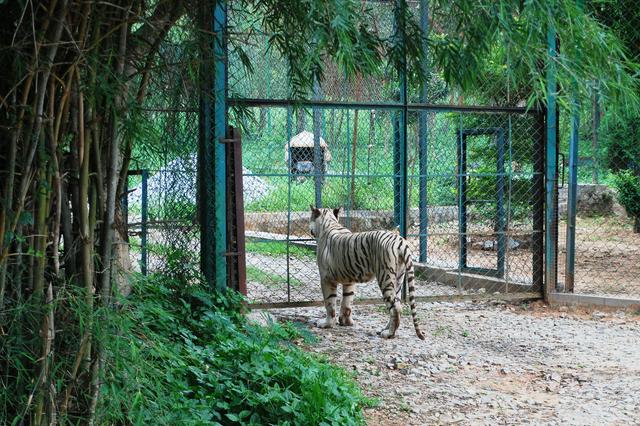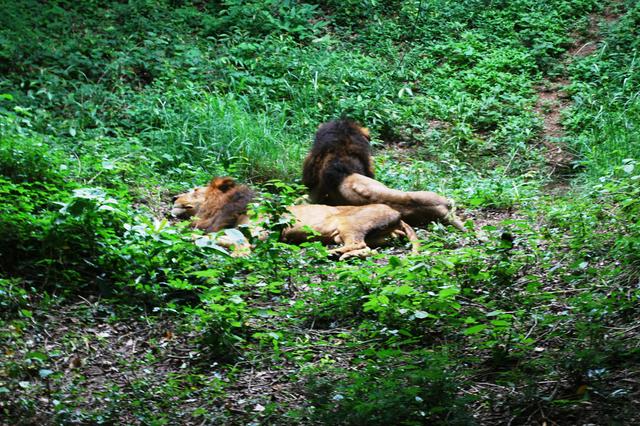Bannerghatta National Park is in Karnataka, about 22 km from Bangalore, in Southern India.
The park was founded in 1970, and declared a national park in 1974. This 104.27 km² national park consists mostly of dense forest and scrub land. There is also a state-run zoo within the national park, which is home to wild animals such as tiger, lion, bison, leopard and wild boar. The national park is an important corridor for elephants migrating between the eastern and western ghats. Other attractions at the zoo include a crocodile farm, serpentarium and a newly added butterfly park. In addition, a portion of the park is used as a sanctuary for rescued wild animals, mainly from circuses. The rescue center is off-limits for visitors. Indulge in your sense of adventure with a lion and tiger safari or a Grand Safari (covering herbivores and big cats).

For an elaborate knowledge of nature and wild-life along with the eco-recreation, eco-tourism and conservation of nature, a 12.8 km² area added the park for a free space for the wild animals to be in their natural habitat. It is a popular tourist destination with a zoo, a pet corner, an animal rescue center, a butterfly enclosure, an aquarium, a snake house and a safari park. It is also a trekking destination. The Zoo Authority of Karnataka and the educational institute such as University of Agricultural Sciences, Bangalore have been establishing good environment to visitors.
India's first butterfly enclosure is at the Biological Park. It occupies, which houses a butterfly conservatory, a museum, and an audiovisual room. The butterfly conservatory consists of a circular dome enclosure with a poly-carbonate roof, of area 930 m² (10,000 sq ft). The conservatory has a humid tropical climate, with an artificial waterfall and appropriate flora, designed to support over twenty species of butterfly. The conservatory leads to a second and third dome, which houses a museum containing dioramas and exhibits of carefully preserved butterflies.
In 2002 a portion of the park, became a biological reserve, which was named "Bannerghatta Biological Park". It is a popular tourist destination with a zoo, a pet corner, an animal rescue center, a butterfly enclosure, an aquarium, a snake house and a safari park. You can find everything from avifauna to Panthers in the Bannerghatta National Park. The zoo is home to panthers, lions, tigers and a large variety of birds. Wander through the Zoological Garden, with its canopy of shady and sturdy trees, find a quiet resting spot beside a pond and watch the waterfowl frolic. The zoo boasts an amazing reptile collection; a snake park lets you get up close and personal with the scaly, slithery creatures. A children's corner provides an added attraction.
Trekking enthusiasts will enjoy Uddigebande (3.5 km) a natural rock formation called Hajaamana Kallu (3 km) and Mirza Hill (1.5 km)
Covering an area of 104.27 km2, including ten reserve forests of Anekal Range of the Bangalore Forest Division, the scenic hills are dotted with many ancient temples.
The Bannerghatta Biological Park is part of a wild-life corridor for elephants which connects the Biligiri Rangana Hills and the Sathya Mangalam Forest. The Bannerghatta Biological Park is a landmark with a connectivity with Talli Reserve Forest in the South-East and Bilikalli Forest in the South.
The beautiful Suvarnamukhi stream running through the park, originates in the Suvarnamukhi hills. These hills spread out to a huge rock, about a kilometre long. The Champaka Dhaama Swamy temple built in the Dravidian style of the Hoysala age, lies at the foot of the rock. The temple enshrines an image of Vishnu with his consorts Sridevi and Bhudevi. The Suvarnamukhi hill also houses a small shrine dedicated to Narasimha(the fourth incarnation of God Vishnu, is half-lion half-human), and at a distance of 2 km away is the Suvarnamukhi water pond. The water of this pond are believed to have curative powers.
A trip to Bannerghatta National Park is truly an unforgettable experience for nature, history, botany and wildlife buffs.
Flora: Dry deciduous forests and thorny scrub, with patches of moist deciduous forests along the streams.
Flora include Latifolia, Schleichera Oleosa, Terminalia Tomentosa, Sandalwood, Neem, Terminalia Arjuna, Grewia Tilaefolia, Santalum Album, Tamarind, Bamboo, Eucalyptus, Bauhinia Purpurea, Samanea Saman, and Peltphorum Pterocarpum.
Fauna in the park include Gaur, Leopard, Jackal, Fox, Wild Boar, Sloth Bear, Sambar, Chital, Spotted Deer, Barking Deer, Common Langur, Bonnet Macaque, Porcupine, Hare, Slender Loris, Monitor Lizard, Cobras, Python, Russell's Viper, Krait and Hippopotamus.
Fauna: Elephant, lion, Bengal tiger, white tiger, panther, bear, bison, spotted deer, birds, butterflies.
You can visit the park year round. The weather is moderate, in the range of 20-32°C year round. The best season is September to January.
 The entry fee is determined based on what you opt for. There are many options available, for example: Zoo + Lion-tiger safari, Zoo + Grand safari, or Zoo only. The prices are slightly higher on holidays (this include weekends, national holidays, and the whole month of May).
The entry fee is determined based on what you opt for. There are many options available, for example: Zoo + Lion-tiger safari, Zoo + Grand safari, or Zoo only. The prices are slightly higher on holidays (this include weekends, national holidays, and the whole month of May).
The park is open to visitors Wednesday to Monday between 9AM and 5PM.
Fees for foreigners from non-SAARC countries (July 2017) for the Zoo, Butterfly Park and the Grand Safari (normal bus) are: adults ₹400, and children ₹300.
Indians and foreigners from SAARC countries may buy separate tickets for each visit (prices shown for adults/children aged between 6 and 12 years/senior citizen 60 years above) (July 2017):
Zoo: adults ₹80, children ₹40, seniors ₹50
Butterfly Park: adults ₹30, children ₹20, seniors ₹20
Grand Safari (normal bus): adults ₹260, children ₹130, seniors ₹150
Check the website for rates for air-conditioned buses, Jeeps, and cars.
A variety of animals are found in the park. Mammals live freely in the forest, and the visitors are taken around the forest in a well caged 'safari' mini-bus to view them. Partitions with huge gates and moats separate the forest into the Herbivorous section (with deers, elephants, bears and a few monkeys) and the Carnivorous section (with white tigers, lions, and Bengal tigers).
There is also a zoo where reptiles, birds and amphibians are looked after in cages. Endangered animals like cheetahs, leopards, hyenas and panthers are kept here. One can see rhinoceros, elephants, zebras, and porcupines in the zoo area. There are also chipmunks (American ground squirrel) which are very rare in India.
- Champakadhama Temple. One of the ancient temples of Bangalore, dedicated to Lord Vishnu, worshipped with Champaka flowers in the olden days. While the main Lord Champadahama Temple is located on the ground level, there is a small Narasimha Swamy Temple on the top of the hill, accessible through a flight of stairs. A small walk behind the Narasimha Temple, leads to a Kalyani in midst of the deciduous forest, having a statue of Lord Anjenya Swamy inside. Access to the Kalyani is prohibited in the dusk time as wild animals tend to move about the area.
Champakadhama Temple. One of the ancient temples of Bangalore, dedicated to Lord Vishnu, worshipped with Champaka flowers in the olden days. While the main Lord Champadahama Temple is located on the ground level, there is a small Narasimha Swamy Temple on the top of the hill, accessible through a flight of stairs. A small walk behind the Narasimha Temple, leads to a Kalyani in midst of the deciduous forest, having a statue of Lord Anjenya Swamy inside. Access to the Kalyani is prohibited in the dusk time as wild animals tend to move about the area.
Once you reach Bannerghatta National Park, go to the ticket counter and collect tickets for Grand Safari, Lion & Tiger Safari, and Zoo Park. On weekends,it is advisable to reach the park before 2PM to avoid nonavailability of tickets.
Then wait in queue to board the green safari mini-buses.
Grand Safari is 16 km (to&fro) while Tiger & Lion Safari is 11 km (to&fro).
Complete the Safari and visit at Butterfly Conservatory on the way back. It houses around 20 species of butterflies in a tropical setting, complete with plants, shrubs and a waterfall. After that, see the beautiful exhibits of preserved, exquisitely colored butterflies and moths.
Walk towards the Zoo Park and check out the caged animals, reptiles, and birds in the zoo compound.
You can buy CDs featuring the butterflies of India from the Butterfly Park.
The Bannerghatta National Park has been strictly made a plastic-free zone and hence all plastic packaged snacks are sold in hand-made paper bags. The Children's corner is surrounded by many stalls and push cart vendors selling mouth watering Indian chaats and snacks. Dry roasted corn and peanuts are popularly bought on demand over here. The National Park also has a Hill View Restaurant maintained by Jungle Lodges and Resorts just a few yards outside the zoo which provides food on order, to the visitors.
If you are going on a weekday, the stalls inside the Zoo serve great varieties of food, it is also better you carry some food with you. Weekends also have no problem.
You can get carbonated beverages and packaged juices inside the zoo park.
Do not put your hands out of the mini-bus while on safari.
Do not try to feed wild animals or birds kept in cages.
